How to Store, Freeze, and Refresh Bread
The ultimate how-to-guide for storing, freezing, and refreshing sourdough or fresh bread at home!
As most of you know, I’ve gotten very into bread baking over the past six months! I started my very own sourdough starter (Breadley Cooper) this past July and have been regularly making this sourdough bread recipe ever since.
It was one of the most fun projects that I tackled in the last year and I can’t wait to share more sourdough bread resources with you this year. If you’re looking to get started, be sure to check out my extensive list of sourdough bread tools for beginner and experienced bread bakers.
One of the most frequently asked questions that I get (particularly over on Instagram) is how I store fresh bread, particularly since I live in a small household and regularly bake two loaves at once.
I’m here today to share all the secrets! Below you’ll find extensive tips on how to store bread, how to freeze bread, and how to refresh bread so that it tastes just as good as new.
Basic Bread Storage Tips:
While there are several ways to store bread, my favorite method is below. This method will ensure that you keep that crisp, crusty exterior for as long as possible. For this post, I’m referring to artisanal boules, batards, baguettes, etc., not your typical sandwich bread from the grocery store.
It is worth noting that one of the benefits of fresh sourdough bread (bread made with a sourdough culture) is that it has a longer shelf life than typical store-bought bread. It can typically last for about 4 to 5 days at room temperature.
Whatever you do, please do not refrigerate your bread. It will cause your bread to stale significantly faster. Depending on how recently your bread was baked, you’ll want to approach bread storage slightly differently.
Why You Shouldn’t Slice into Warm Bread:
It is very important to allow bread to cool completely to room temperature before storing or slicing. Place it on a cooling rack and resist the urge to dig into it. Slicing fresh warm bread out of the oven, while extremely tempting, affects its texture and flavor (it will be gummier and less airy; and will result in loaf that dries out much faster).
How to Store Bread
Day One – Day Two:
- for bread that has just been baked, I always leave it out, completely uncovered, at room temperature on the first day of baking. The crust on freshly baked bread will remain at its best texture for at least one day, if not two full days.
- If you slice into your bread: it is best practice to leave it cut-side down on a cutting board uncovered, particularly if you enjoy a crisp crust. This will help protect the interior from drying out, but not result in any moisture collecting on the crust and it becoming too soft.
- If you have not sliced into your bread: if I choose not to slice into the bread on the day of baking, I generally transfer the whole loaf to a large paper bag and fold over the edges. While the crust won’t be quite as crisp as the first day of baking, the porousness of the paper bag will allow air to circulate, yet also help it not dry out too quickly.
Day Three – Day Four:
- While the above method works really well for freshly baked bread, you’ll want to cover it a couple days after it has baked, otherwise it will dry out quickly and become stale/too hard to slice.
- Usually by day three, the best option is to store it bread box (if you have one) or a large Ziploc bag. It’s important to note that this isn’t a perfect solution, bread (or covering it tightly) in this manner will inevitably cause the moisture from the loaf to be trapped, resulting in a softer textured crust. You can get around this by toasting your bread lightly.
- Alternatively, you can also wrap your bread in natural beeswrap (affiliate link) which is a wonderful and better alternative as it is naturally porous and won’t cause as much moisture to be trapped!
Day Five +:
- Why haven’t you eaten all your bread? No, but seriously, if you do not plan on consuming your whole loaf of bread within the first few days of baking, I generally always advise storing it in the freezer (see my instructions below).
How to Freeze Bread:
One of the best tools in your kitchen for storing bread is the freezer! If you have limited access to fabulous bread or need to buy bread many days (to a few weeks) in advance of a dinner party or special occasion, I highly recommend buying an extra loaf or two, freezing the loaves, and enjoying them at a later date.
Since I bake two loaves of sourdough bread at a time, I almost always freeze my second loaf. If I follow a few basic steps, that frozen loaf out of the freezer can taste just as good as the freshly baked loaf.
For freezing bread, it is very important to allow your bread to cool completely before freezing. If stored properly, bread can be stored in the freezer for about 3 to 6 months; however its flavor will diminish the longer it is stored.
How to Freeze Whole Loaves of Bread:
To freeze entire loaves of bread, allow the bread to cool completely, then transfer to a large, durable Ziploc bag, press out any excess air, and seal. If you are all concerned that your bread crust will puncture the bag, you can wrap the loaf tightly in plastic wrap, aluminum foil, or place it in a small paper bag, and then transfer it to a Ziploc bag.
This is my favorite method for short or long term bread storage. My frozen bread loaves taste just as good when refreshed properly, as my freshly baked bread loaves do.
How to Freeze Sliced Bread:
If you only consume a small amount of bread at a time (or have it occasionally here and there) or have a small household, one fabulous way to store bread is to slice it before freezing.
To do this, slice your bread evenly with a serrated bread knife and transfer it to a large Ziploc bag. If your crumb is extremely moist, I advise placing a small piece of parchment paper between each slice to ensure that the slices don’t stick together.
This method allows you to take one slice out at a time, toast it (undefrosted) in your toaster or favorite method of choice, and have a delicious breakfast or snack whenever you want!
How to Refresh Bread Perfectly:
This is my favorite method for freezing (and refreshing) whole loaves of bread. It sounds a bit crazy, but you will be amazed at the results. This results in a very crisp crust that tastes and feels as it does just after baking.
I promise, once you try this method, you will never go back! Your frozen bread will taste like you just baked it. Even if you have a lackluster loaf of bread from a bakery (the crust has softened considerably), try this method below, and it will be elevated instantly.
This method works incredibly well for artisanal loaves of bread, as well as baguettes, etc.
How to Refresh Whole Loaves of Bread:
- Allow your frozen loaf of bread to thaw (in the bag) at room temperature for several hours or overnight on your countertop the night before.
- Preheat your oven to 350 degrees Fahrenheit (175 C) for at least 20 minutes with a rack in the center position.
- Remove the loaf of bread from the bag and lightly run it, very quickly, under cold water. You do not want to saturate your loaf of bread, just lightly saturate/spritz it evenly with cold water on all sides. This light coating of water steams in the oven and results in a far crisper, fresher crust than placing a loaf in the oven dry. *Do not complete this step until your oven is completely preheated and you’re ready to stick it in the oven.
- Place the whole loaf of bread directly on the oven rack and bake for 15 to 20 minutes, or until the crust is crisp and cracks slightly when compressed slightly. This time might vary slightly depending on the size of your loaf of bread (baguettes might only need about 15 minutes at the most), but I always err on the longer side.
- Remove and allow your perfectly crisped, refreshed loaf of bread to cool completely on a cooling rack – usually at least an hour – before slicing. Store bread as directed above. I generally find that refreshed whole loaves of bread will store just as well, perhaps drying out slightly faster, as freshly baked loaves.
Let me know if you have any questions below and I’m happy to answer them!

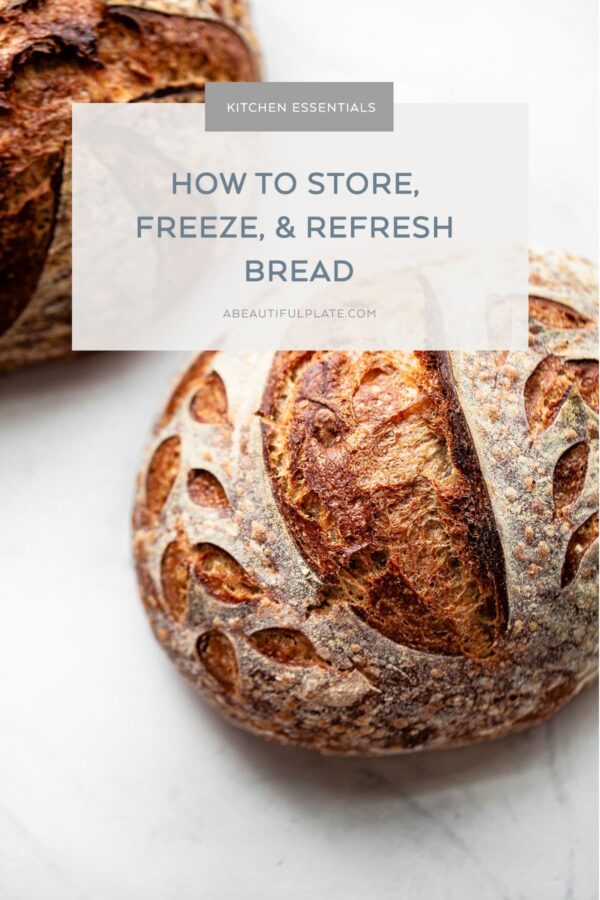
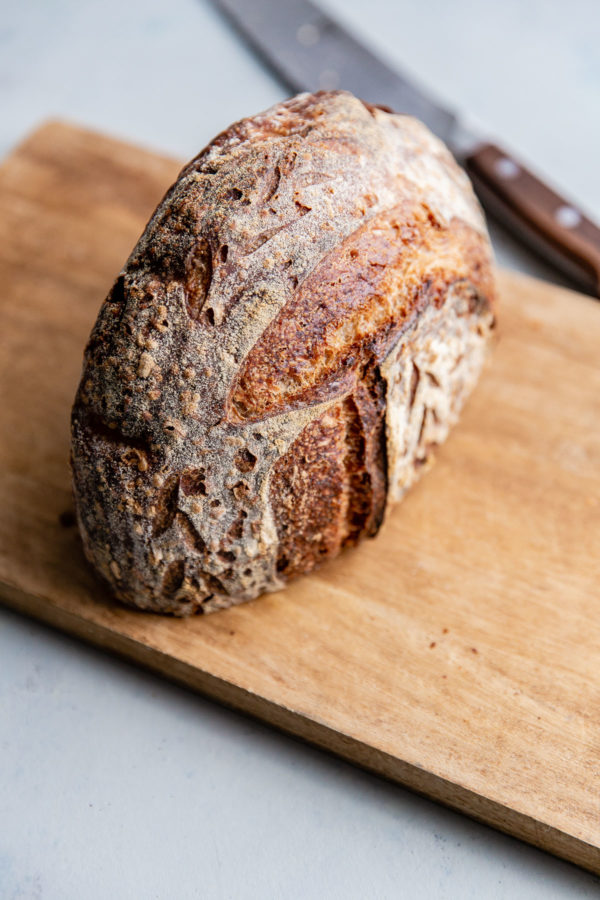
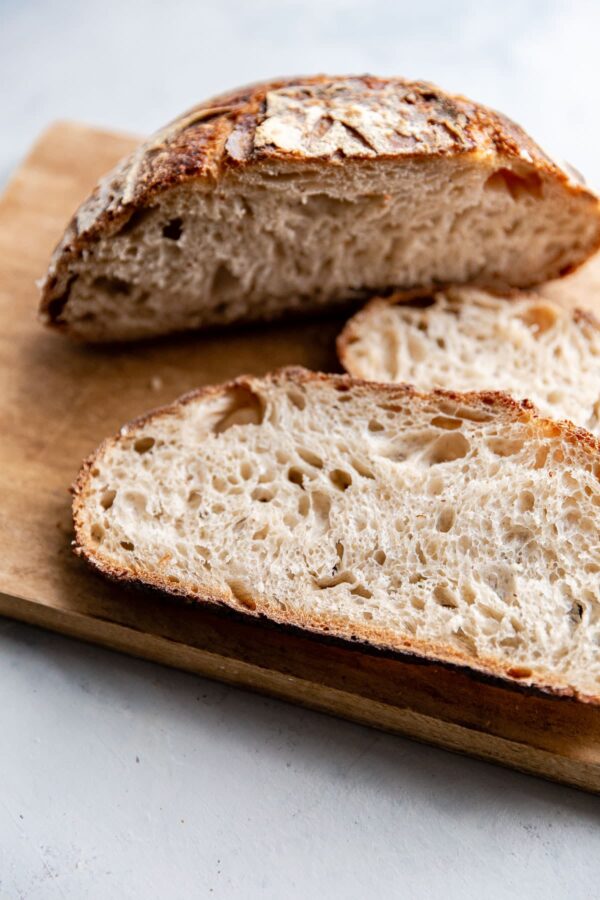
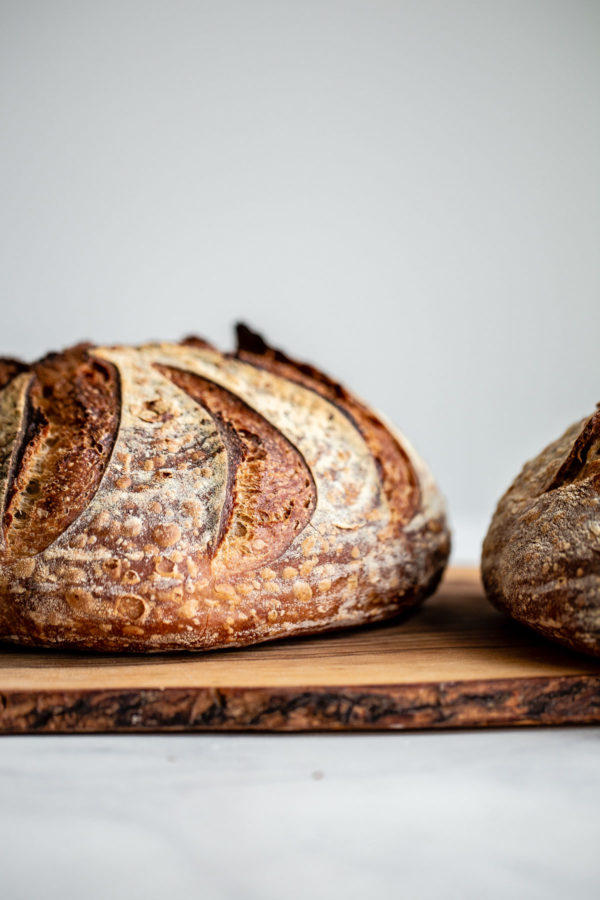
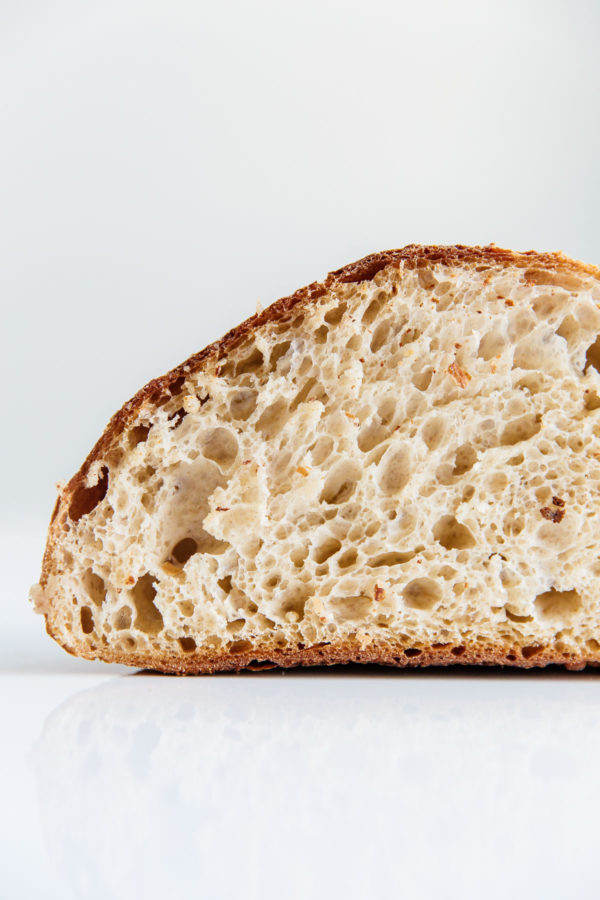
47 Comments on “How to Store, Freeze, and Refresh Bread”
After I have frozen my Sourdough bread I seal a meal it. Is it pantry stable or do I have to keep frozen? Running out of freezer space. Thank you.
Yes, you will need to freeze the bread unless you are eating it that day into the next few days. It is not pantry stable unless there are preservatives added, and I don’t even think it’s possible then.
Advice on using stale sourdough bread for breadcrumbs. Thanks so much.
Hi Susan. You can definitely do this – I sometimes will remove the crusts if they’re really dark and I generally prefer using the breadcrumbs for a topping, as opposed to necessarily breading if that makes sense. They’re great on salads, etc. Here’s a good recipe concept to try: https://www.abeautifulplate.com/crispy-garlic-bread-crumbs/
If you’ve already cut a few slices- is it ok to still freeze/and refresh the whole loaf? I did this as I was in a hurry and worried I had kept it out too long (4 days). Wish I had sliced it first but I didn’t.
You can wrap the entire thing in foil to put in the oven and refresh it that way – or alternatively, you could keep slicing and freeze the slices!
Thank you for this wealth of information! I just bought four loaves of the best fermented homemade sourdough bread I have ever tasted. Immediately ate two large slices. I will definitely be freezing the other full loaves.
Hi 🙂 I am wanting to mail my home made sourdough to family out of state. I’m thinking of wrapping in tinfoil, then bagging, then freezing the loaf, then mailing with dry Ice and including your refresh instructions. Do you think this would be the best method? Thanks!!
I don’t think dry ice is necessary – I would just freeze solid and send priority 2-day mail, and definitely include the refresh instructions. What a lovely idea!
I’m trying to not use my oven to reduce energy costs can the bread be baked and or refreshed in a ninja or combo grill, oven microwave, if so can you tell me cooking times and refreshing times for that method thanks.
You could certainly do this in a toaster oven if it’s big enough, but I’ve never seen an air fryer that could accommodate a typical loaf of sourdough.
Unfortunately I can’t give time specifications (you should use similar temp and check after 10 minutes) because I don’t own any of those devices and there’s too many differences even among sizes/brands.
I’ve been looking for a way to keep my breat crisp and this sounds like the best way. Storing it in the freezer is something I will have to try.
Thanks for the tips
Arthur
Hi
Really good tips here. Previous to reading this I’ve been wrapping my sourdough in plastic wrap then popping into a paper bag before freezing.
Once thawed though I’ve noticed the edge of my sliced bread looks slightly white and has shrunk.
I let my baked sourdough bread sit out several days and then put 1 loaf in a Foodsaver bag removing most of the air and then putting it in the freezer, The other loaf I cut into slices and put the slices, two at a time, in a sandwich bag. I don’t close the sandwich bag and start putting each two piece bag in another Foodsaver bag and remove most of the air. I leave out several sandwich bags to be eaten and when I need more bread, I take out several sandwich bags and let it defrost and set out until eaten. It may not be the best way, but it works for us. When I need the e other loaf, I take it out and slice it, putting two slices in a sandwich bag, back into the Foodsaver bag and back into the freezer.
That’s great! Glad you found a method that works well for your family.
I usually bake the traditional sourdough bread in a cloche and resist slicing into it for 24 hours. I then slice it and wrap two slices in plastic wrap and place in a freezer bag. This method works quite well and the night before breakfast I let two slices sit on our counter and in the AM they are perfect. I only started making sourdough when the Covid hit.
My first starter (Lucy) didn’t survive but my 2nd try (Ethel) has been going since December of 2020.
I definitely recommend slicing into a few hours later (when it’s totally cool) – unless you are baking rye breads, there is something about that same day texture/crust that just won’t be the same on the second day. I will also keep sliced bread in a freezer bag for toasting (no need for plastic wrap in my opinion!).
What’s the best method to defrost sourdough bread, and how long will it last well in the pantry.
Hi Phyllis, I actually have a guide that’s about that topic, you can find it here:
https://www.abeautifulplate.com/how-to-store-bread/
Hope this helps!
Hi there! Can I skip the thawing process and put the loaf straight in the oven? I read somewhere that you can defrost at 350° for 40 minutes. Thanks!
This could work too, I might personally reduce the temperature by 25 degrees, because you don’t want it to gain much more color. I bake my loaves fairly dark as is, so it might just depend on how you bake your loaves!
Tnx Laura for your tips.
can I freeze half or quarter loaf ( not sliced) same way as whole loaf?
also, can I freeze it after 2-3 days of baking and storing in bread box, if I don’t finish it by then?
I hate to waise it….
You can’t refresh a partial loaf quite the same way (with the oven refresh!) because the crumb is exposed. If you are interested in freezing a smaller portion of a loaf, I would recommend slicing it and freezing it that way – then you can defrost / toast. Yes, you can certainly freeze bread after it has sat out for a few days too, it might be marginally less fresh, but will work just as well.
I really like your method to refresh a frozen loaf, since nothing tastes as good as freshly baked bread. I have a couple of loaves in the freezer and will try it soon. One question, will it make any difference if I heat the frozen loaf in a Dutch oven rather than just the oven rack? Maybe, reduce the time in the oven?
No, I don’t think so! It could insulate a loaf that was baked darker (if you were concerned about it gaining more color) but otherwise seems like it wouldn’t make any difference to me. I also think it would be best if it was exposed for the water to evaporate better! Dutch ovens are more for trapping steam.
Have you ever tried freezing the unbaked sourdough loaf in the banneton and then putting it in a zip lock to bake another day??
No, I personally would always rather refresh a baked loaf, that is the more common way to do things. You could try this, but it would be frozen solid in the center – that’s my educated guess! Alternatively you could bake a loaf to be more blonde – don’t the the color as far – then allow it to brown more in a second bake.
Thanks for this great advice Laura. Just one clarification please: if you keep a freshly baked sourdough loaf out of the freezer for use in Day 3, can you refresh it the same way as your instructions for loaf taken out of freezer- ie spritz with water and put in oven for 20 mins?
Hi Laura, thank you for a great post. I am preparing to bake my first sourdough bread ( growing my starter now). I want to know, when you bake two loaves, d you bake one at the time, or both at the same time. I only have 1 Dutch oven at this time. Will the second loaf overproof while the first is baking? I’m planning on baking over the weekend as I work full time during the week and will have no time for long fermentation during the week.
You can also use a straw to suck out the air from the ziplock bag. That’s what I do if I don’t want to use my FoodSaver because the food is extremely soft.
This is so smart! Great idea, thanks for sharing!
Very helpful article. For freezing, I have been wrapping my whole or sliced freshly made sourdough bread in foil, then sealed in a ziplock. Is the foil necessary?
Hi Mark! Foil shouldn’t be necessary, I just put my loaves in large Ziplocs and try to press out any excess air. I haven’t stored bread for incredibly long stretches, but don’t see the need for any foil when using this method. Hope this helps!
Ok. I will try it. Thought it was necessary to minimize contact with the air. Thanks.
This is great advice. Now I don’t have to be anxious about finishing my sourdough projects so fast.
How long does a refreshed frozen loaf last? Does it need to be all consumed that day?
No, definitely not! In my experience, a refreshed loaf has pretty much the same shelf life as a just baked one (perhaps a day less?). You could also slice any leftovers and freeze them for easy toasting.
Does freezing destroy the good bacteria in sourdough bread?
Hi Ruth! Not sure what you mean. There is no active bacteria in bread, as it has baked at a high temperature so any sort of bacteria (good or bad) would no longer be viable after that. Many people do find it easier to digest though due to the long fermentation.
You mention these are specifically not for store bought sandwich bread. But what about homemade sandwich bread? I don’t make baguettes or sourdough. Just regular white sandwich bread and would really rather not use single-use plastic like I have.
Hi Anna! Great question. I have a feeling you could definitely use beeswax paper to store those loaves – but you might want to consider a bread box? I feel like that might be the best option for you, especially if you make sandwich bread regularly, especially if you are mostly looking to reduce single use plastic. Are you mostly just looking to reduce single use plastic? Sourdough holds up a bit better than traditional yeast breads, which is why it is a bit hard to tell.
Wow very interesting thanks! Does the running water over a thawed frozen loaf work if its only half a loaf? Presume so just turn it cut down and make sure to only run water over the crust not the inside of the loaf? ?
I’ve never tried this method with a cut loaf and don’t really recommend it. The baking time will most likely be way too long and the loaf could easily dry out without having the crust as insulation.
Pingback: No-Knead Sourdough, Beginner Sourdough Bread| Baker Bettie
These are great suggestions, especially the reassurance about wrapping bread in beeswax.
Can you recommend a freezer storage method that does not include single-use plastic?
Thank you!
Hi Stephanie! There aren’t a lot of options aside from a silicone reusable bag – but not many come in the size that you’d need to store a whole loaf. I use a Ziplog bag, and just reuse it many times. As long as it doesn’t become punctured or contain meat, it is very easy to rinse and just dry – and reuse many times. When it does become unusable, I recycle it with my other soft plastic at a soft plastic recycling center (cling wrap is not soft plastic, so I try to avoid using that). For more tips, check out this post: https://www.abeautifulplate.com/ways-to-reduce-kitchen-waste/
For one day old bread that’s not crispy because I wrapped it in foil, should I refresh using the water method or is there a better way? New to baking bread and wasn’t sure how to store two loaves baked for a party overnight. Thanks